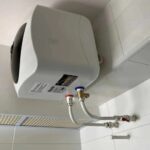Induction Cooktops (85-190 units of electricity per month)
Induction cooktops are gaining popularity, especially in households as an alternative to traditional gas stoves. There are two main types: single burners with a compact design, often used for hot pot meals, and double or triple burners that are usually installed permanently in the kitchen.
A single burner, used for approximately three hours daily, can consume between 85 to 95 units of electricity monthly. In contrast, a double burner has a higher consumption rate, ranging from 170 to 190 units per month. Actual electricity consumption may vary depending on the power output and type of cooktop used.

Induction cooktops are becoming a popular choice, especially in households opting for an alternative to traditional gas stoves.
Water Heaters (70-340 units of electricity per month)
Water heaters are prevalent, especially in the northern provinces of Vietnam due to the climate. Most families use a 20-liter capacity heater, sufficient for the daily needs of 2-4 people.
If the heater is turned on only when needed and used for an average of one hour per day, electricity consumption can range from 70 to 80 units per month. However, for families that keep the heater on continuously, consumption can reach 230 to 340 units, according to statistics from EVN.
Electric Kettles (40-100 units of electricity per month)
Electric kettles are widely used in Vietnamese households to provide hot water daily. They typically have a capacity of 4 to 6 liters and work by boiling water, maintaining its temperature for six hours or more, or as per the temperature setting.
Kettle power outputs range from 700 to 1,200 W, depending on the manufacturer and capacity. With continuous use and a consumption of about 6-8 liters of hot water daily, an electric kettle can use up 40 to 100 units of electricity monthly.

Electric kettles are a common appliance in Vietnamese households, providing hot water for daily use.
Clothes Dryers (75-140 units of electricity per month)
Clothes dryers are gaining popularity in Vietnam due to their convenience and time-saving benefits, especially during rainy days or periods of high humidity. The two common types of dryers are vented and condenser dryers, typically with an 8 kg capacity. Using a dryer for 1 to 2 hours daily consumes 75 to 140 units of electricity monthly. However, higher-end dryers, such as those using heat pump technology, have significantly lower power consumption.
Desktop Computers (72-75 units of electricity per month)
Desktop computers are a familiar technology in many homes, with an average power consumption ranging from 35 to 450 W. Some higher-spec machines can consume up to 1,000 W. According to EVN data, the average monthly electricity consumption of a desktop computer is typically between 72 and 75 units.
Refrigerators (10-75 units of electricity per month)
Refrigerators are essential appliances in most households and run continuously 24 hours a day. Smaller refrigerators with a capacity of less than 100 liters consume about 10 to 15 units of electricity per month. Medium-sized refrigerators with a capacity of less than 300 liters consume 30 to 45 units, while larger refrigerators over 400 liters can consume 50 to 75 units of electricity per month.
The Power Drainers: Unplug These Devices After Use or Risk a Shocking Electricity Bill
“It was an eye-opener when an electrician friend of mine pointed out how certain electrical appliances, if left on standby mode for extended periods, can rack up substantial electricity costs. This got me thinking about how many of us are unaware of these hidden energy drains and the subsequent impact on our wallets and the environment.”
The Modern Kitchen Revolution: Why More Homes Are Moving Away From Gas Stoves
Many people are wary of using gas stoves, primarily due to safety concerns. There have been instances of gas leaks and even explosions caused by improper use, which has led to a sense of apprehension among some users. While these stoves are a common fixture in many households, it’s essential to acknowledge and address these valid safety worries.




































